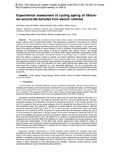Mostrar el registro sencillo del ítem
Experimental assessment of cycling ageing of lithium-ion second-life batteries from electric vehicles
| dc.creator | Braco Sola, Elisa | es_ES |
| dc.creator | San Martín Biurrun, Idoia | es_ES |
| dc.creator | Berrueta Irigoyen, Alberto | es_ES |
| dc.creator | Sanchis Gúrpide, Pablo | es_ES |
| dc.creator | Ursúa Rubio, Alfredo | es_ES |
| dc.date.accessioned | 2021-03-10T13:53:51Z | |
| dc.date.available | 2022-12-01T00:00:14Z | |
| dc.date.issued | 2020 | |
| dc.identifier.issn | 2352-152X (Electronic) | |
| dc.identifier.uri | https://hdl.handle.net/2454/39372 | |
| dc.description.abstract | The reutilization of batteries from electric vehicles allows to benefit from their remaining energy capacity and to increase their lifespan. The applications considered for the second life of these batteries are less demanding than electric vehicles regarding power and energy density. However, there is still some uncertainty regarding the technical and economic viability of these systems. In this context, the study of the ageing and lifetime of reused batteries is key to contribute to their development. This paper assesses the experimental cycle ageing of lithium-ion modules from different Nissan Leaf through accelerated cycling tests on their second life. The evolution of the internal parameters during ageing and the correlation between them are shown, including the analysis of best fitting curves. In addition, a second-life end-of-life criterion is proposed, based on capacity and internal resistance measurements during cells ageing, which can be applied to real application in order to prevent safety issues. By estimating future values from degradation trends and checking latter measurements, the ageing knee is identified. Results show that the modules operate for at least 2033 equivalent full cycles before reaching their ageing knee. This would mean more than 5 years of operation in a real second-life application, such as a photovoltaic self-consumption installation with daily cycling. Moreover, it is shown that a traditional cell characterisation based on capacity and internal resistance measurements is not enough to predict the durability of a cell during its second life. | en |
| dc.description.sponsorship | The authors would like to acknowledge the support of the European Union under the H2020 project STARDUST (774094), the Spanish State Research Agency (AEI) and FEDER–UE under grants DPI2016–80641-R, DPI2016–80642-R, PID2019–111262RB-I00 and PID2019–110956RB-I00, of Government of Navarra through research project 0011–1411–2018–000029 GERA and of Public University of Navarre under project ReBMS PJUPNA1904. | en |
| dc.format.extent | 14 p. | |
| dc.format.mimetype | application/pdf | en |
| dc.language.iso | eng | en |
| dc.publisher | Elsevier | en |
| dc.relation.ispartof | Journal of Energy Storage, 2020, 32, 101695 | en |
| dc.rights | © 2020 Elsevier Ltd. This manuscript version is made available under the CC-BY-NC-ND 4.0 | en |
| dc.rights.uri | http://creativecommons.org/licenses/by-nc-nd/4.0/ | |
| dc.subject | Cycle ageing | en |
| dc.subject | Energy storage | en |
| dc.subject | Electric vehicle | en |
| dc.subject | Lithium-ion battery | en |
| dc.subject | Renewable energy | en |
| dc.subject | Second-life battery | en |
| dc.title | Experimental assessment of cycling ageing of lithium-ion second-life batteries from electric vehicles | en |
| dc.type | info:eu-repo/semantics/article | en |
| dc.type | Artículo / Artikulua | es |
| dc.contributor.department | Ingeniaritza Elektrikoa, Elektronikoaren eta Telekomunikazio Ingeniaritzaren | eu |
| dc.contributor.department | Institute of Smart Cities - ISC | en |
| dc.contributor.department | Ingeniería Eléctrica, Electrónica y de Comunicación | es_ES |
| dc.rights.accessRights | info:eu-repo/semantics/openAccess | en |
| dc.rights.accessRights | Acceso abierto / Sarbide irekia | es |
| dc.embargo.terms | 2022-12-01 | |
| dc.identifier.doi | 10.1016/j.est.2020.101695 | |
| dc.relation.projectID | info:eu-repo/grantAgreement/European Commission/Horizon 2020 Framework Programme/774094 | en |
| dc.relation.projectID | info:eu-repo/grantAgreement/ES/1PE/DPI2016-80641-R | en |
| dc.relation.projectID | info:eu-repo/grantAgreement/ES/1PE/DPI2016-80642-R | en |
| dc.relation.publisherversion | https://doi.org/10.1016/j.est.2020.101695 | |
| dc.type.version | info:eu-repo/semantics/acceptedVersion | en |
| dc.type.version | Versión aceptada / Onetsi den bertsioa | es |
| dc.contributor.funder | Gobierno de Navarra / Nafarroako Gobernua, 0011–1411–2018–000029 GERA | es |
| dc.contributor.funder | Universidad Pública de Navarra / Nafarroako Unibertsitate Publikoa, ReBMS PJUPNA1904 | es |



